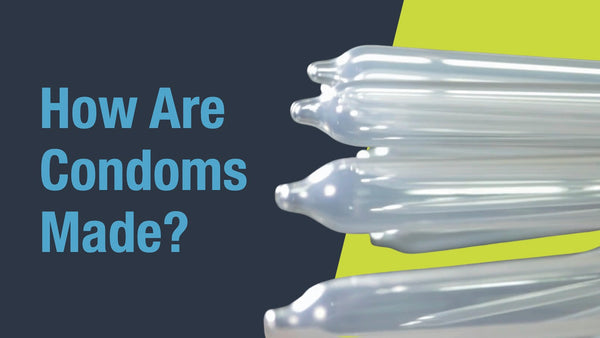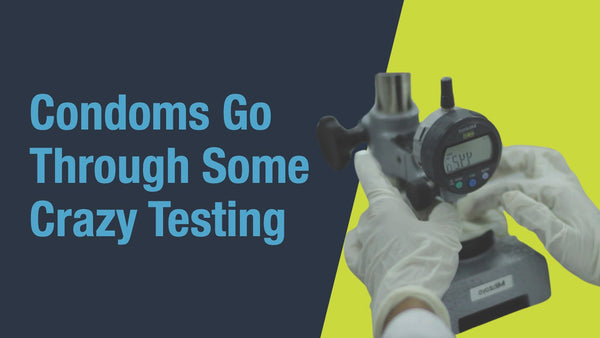
In honor of National Condom Month, we’re sharing some of our favorite things you may not know about condoms. Global Protection Corp. has been around since 1987, and we’re big fans of condom history, condom manufacturing, and bringing new innovations to the market. Have something else to add or have a question? We’d love to hear it!

They’ve been around forever!
The first mention of a condom-like device appears in 3000 BCE when King Minos used a goat bladder as a barrier method during sex to avoid killing his mistresses with semen made of “serpents and scorpions.” Historically, condoms have been made anywhere from a cloth to a turtle shell. The good news is that condoms have come a long way, changing materials from latex, to non-latex, to now even the world’s first graphene condoms. There are various styles from ribbed and studded to flavored, glow in the dark, and hyperthin. And because we’re passionate about proper condom fit, we also launched a condom with 52 different condom sizes.
The initial version of the condom we know today was developed in 1855 after Charles Goodyear discovered rubber vulcanization. Rubber was wrapped around a custom mold and cured, leading to a thick, but reusable condom. Julius Fromm can be credited for creating a new and improved manufacturing process by dipping glass molds into rubber. By the 1920s, latex was invented by suspending the rubber in water, which allowed dipping the molds to be safer and easier. Although we now have machines rather than making each by hand, much of the overall process has stayed the same.

Condoms are medical devices!
The 1976 Medical Device Amendments Act allowed the FDA to establish a classification system which determined the amount of regulation needed to ensure a device is safe for public use. Medical devices fall into three different classes: Class I, Class II, and Class III. Condoms, and almost half of all FDA classified medical devices, fall under Class II. These are devices that have a moderate to high risk to the patient and/or user. Other items in this category are pregnancy tests, contact lenses, and battery powered wheelchairs. Because condoms are classified as medical devices, they must meet rigorous safety testing standards as outlined by the FDA and international standards organizations. Therefore, you know that the products you receive have gone through rigorous testing – and thus can have confidence using them. The key to condom use is using them consistently and correctly; read our condom instructions here.

How are condoms made?
As we discussed above, condom manufacturing begins with glass formers dipped in liquid latex. The process is repeated multiple times so that the latex is distributed evenly. Industrial ovens and cooling cycles between dips maintain thickness and strength. After dipping and heating, condoms are dried, undergo leeching to remove chemicals and proteins. This involves rinsing the condoms with water jets and then tumbling them dry in large industrial dryers, producing the "raw" condom. After the condoms are dried and powdered (so they don’t stick), they’re lubricated, rolled and placed in wrappers! Condoms also go through rigorous testing as described in the next section.
Watch the video below and check out our other blog to learn more!

Condoms go through some crazy testing!
To ensure medical safety regulations are met, condoms go through strenuous testing methods. The six main tests include electronic testing, dimensional testing, air burst testing, leak testing, tensile testing, and package integrity testing.
Electronic testing is the only test performed on every single condom, and is what manufacturers mean when they refer to "individual" or "electronic" testing. Electronic testing checks for pinholes or microscopic tears by subjecting condoms to an intense electrical field. To perform the test, a condom is pulled over a metal form called a mandrel. The condom is then placed into the presence of an intense electrical field, which is created in air or water depending on the equipment used by the manufacturer. Because rubber is an insulator (it does not conduct electricity), no electricity should reach the metal mandrel under the condom. If the electricity reaches the metal mandrel, it indicates the presence of a pinhole. Any condom failing this test is discarded (machines discard the failures automatically).
Dimensional testing ensures standardized sizing throughout the lot by measuring length, width, and thickness against the specifications for that specific condom style & brand. If the samples do not meet the acceptance criteria, the entire batch is discarded.
Air burst testing assesses the condoms' ability to withstand air pressure without breaking; the amount of air is determined by the size of the condom, but equates to the same amount of pressure. To perform this test, a random sample of condoms within the same production lot are filled with air until they pop. The air pressure and amount of air inside the condom are measured at the time the condom breaks. If the burst numbers are too low, the entire batch is discarded.
Leak testing involves filling a sample condom with water to identify any holes. Tensile testing evaluates the ring's tightness by stretching it until it breaks, validating claims for "extra strength" condoms. Package integrity testing uses vacuum technology to detect air leaks or holes in the wrapper seal, ensuring customers receive undamaged condoms. If any issues are found, the whole batch is discarded. If any of these tests do not meet the acceptance criteria, the condoms fail this test and the entire batch is discarded.
Learn more about condom testing here.

One size does NOT always fit all
Yes, lots of people around the world use the regular condom size or XL condom size successfully and with pleasure - and that’s amazing! But because penises come in all different lengths and girths, sometimes the standard condom size just doesn’t work properly for all people. We believe everyone deserves to wear a condom that fits comfortably and works as intended – and that by encouraging proper condom fit, we can increase condom use.
When someone says that condoms don't fit them, we often assume they are complaining about it being too small. But, condoms can be uncomfortable for a number of reasons other than a tight squeeze. The average penis length is 5.5 inches but the standard condom length is around 7 inches. In fact, regular condoms are too long for 91% of people. When a condom is too loose or too long, it can lead to slippage and put the person at risk of unintended pregnancy or STIs.
Worrying about condom fit can also distract from pleasure and confidence. We’ve all seen (or done) the condom over an arm/ foot demonstration to show just how much it can stretch. But just because something stretches & fits doesn’t mean it’s comfortable. An arm or foot has a solid bone in it, versus a boner, which, despite its name, has to work super hard to pump blood to stay erect.
When condoms are too tight, they can cause instant erection loss or the dreaded “red ring of death” (like when you have a rubber band on your wrist too long and it leaves a painful mark). Wearing a condom that is too tight can increase the risk of breakage, cause decreased sensation, and make it difficult to maintain an erection.
Think of condom sizes like shoes; would people wear shoes that “fit”, but that are way too tight? Of course not! Those shoes would hinder performance, comfort, and people would just go barefoot.
This is why we launched a brand called MyONE® Custom Fit™ with 52 condom sizes, including sizes snugger and larger than any other brand. We put together a blog post about how educators can get involved in the conversation, why condom fit matters, and a Dic(k)tionary with more information about the brand and proper condom fit.